Collaboration is a process that brings people together and helps them organize. Furthermore, it enables teams to divide duties and achieve formidable accomplishments.
However, collaborating effectively is not a gift — it’s a skill, or a set of skills, that everyone can develop and improve.
By developing good collaboration skills in a team, overall efficiency is boosted, relevant results are improved, and common goals are achieved much more easily.
In this article, we will take a look at:
- The definition of collaboration skills,
- The most important skills for successful collaboration,
- Good collaboration skills examples, and
- Ways to improve collaboration skills for individuals and teams.
Let’s dive right in!
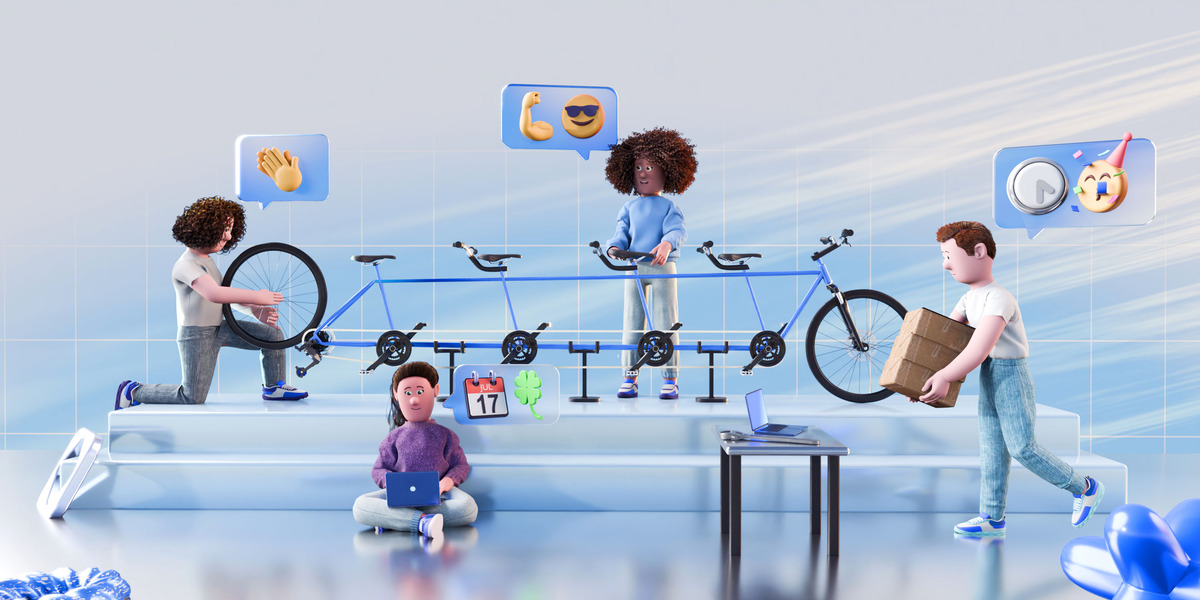
What are collaboration skills?
Collaboration skills include multiple behaviors, soft skills, and mindsets that help any team function and perform better, for the benefit of all involved parties and short-term and long-term company goals.
By taking different collaboration aspects into account, we can arrive at a comprehensive collaboration skills definition:
Collaboration skills are the aggregation of skills identified as relevant to the process of collaboration, such as:
- Team communication,
- Emotional intelligence, and
- Operational know-how.
Therefore, we can observe a collaborative skill set that enables us to work well with others, and analyze behaviors that drive the positive results related to effective collaboration.
Examples of top collaboration skills in the workplace
Although aware of the crucial nature of collaboration, many people still don’t realize which skills they need to develop to claim the title of a good collaborator and team player.
All things considered, the top collaboration skills in the workplace that everyone should work on are:
- Communication,
- Open-mindedness,
- Compromising,
- Organization and delegation,
- Long-term thinking,
- Trust,
- Positivity, and
- Conflict resolution.
So, let’s analyze successful collaboration examples and see how these skills shape a strong work environment.
Collaboration skill #1: Communication
Group communication is vital for the success of any team. It can facilitate not only collaboration but also decision making. It’s also an effective way to manage and resolve conflicts within the team.
However, communicating effectively in a group isn’t easy — sometimes, people who are excellent communicators in a one-on-one setting, can’t find a good way to communicate their thoughts in a group.
To accommodate all its members and their various styles of communication, it’s vital that the team makes room for all types of communication and communication channels.
Here’s a good example of that.
The team needs to brainstorm about the format for their new proposal. Even though some of the team members started sharing their ideas via messages, one of their teammates suggested making a call, which others accepted. By picking a communication channel more suitable for the activity they’re doing (brainstorming), they made their communication more efficient, as it became easier to share ideas and opinions.
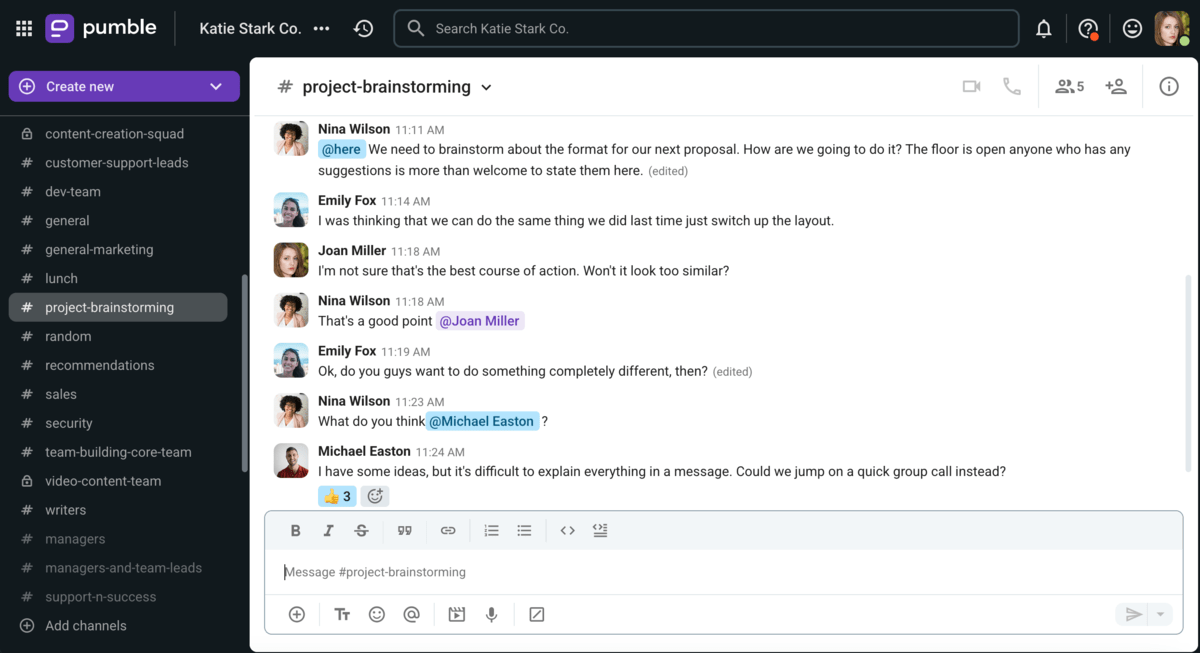
Organize your team with Pumble
🎓 Pumble Pro Tip
Improving communication on an individual level as well as on a group level is vital for collaboration. If you want to know more about how you could improve the effectiveness of your group communication, read the following article:
Collaboration skill #2: Open-mindedness
Being open to new ideas as well as respecting that not everyone thinks as we do is the foundation of good collaboration. Open-minded people:
- Don’t mind having their ideas questioned, improved upon, or challenged,
- Can admit when they are wrong and change their perspective,
- Are humble about their knowledge but aren’t shy to share it,
- Believe that everyone’s voice and opinion are worth hearing, and
- Have a strong sense of empathy.
But, how does that translate into collaborating as a team?
Well, collaborating teams rarely have members who all have the same skills and expertise. Instead, most teams are cross-functional — with members from different parts of the company, who have complementary (but different) skill sets and are working together to achieve a common goal.
When working in such a team, it’s vital that we keep in mind that each member might have a different perspective when it comes to specific problems or topics.
Being open to those points of view and new ideas cultivates a productive, collaborative environment.
Collaboration skill #3: Compromising and adaptability
Out of all collaboration skills, compromising or adaptability might be the most difficult to master.
When we’re working as a part of a team, we expect everything to go off without a hitch. However, the reality of most projects is that something will go wrong — the deadlines will get pushed, priorities will shift, and ideas will get scrapped.
How we react and behave in such situations is a reflection of our adaptability.
The ability to think of your team’s needs and work with others to achieve a happy medium (or a compromise) is vital for the success of every team. When members of a team have conflicting views or ideas, their ability to meet in the middle determines the likelihood of their overall success.
Prioritizing finding an effective solution over being right is of the utmost importance for team collaboration because it can help the team members:
- Work without conflict,
- Resolve arguments and issues more quickly,
- Come up with better, more innovative solutions, and
- Get along better.
For example, a video creator and social media specialist may disagree about the best time for posting a new video product. However, both of them can find a compromise and agreeable solution that meets the needs of both parties, as shown in the example below.
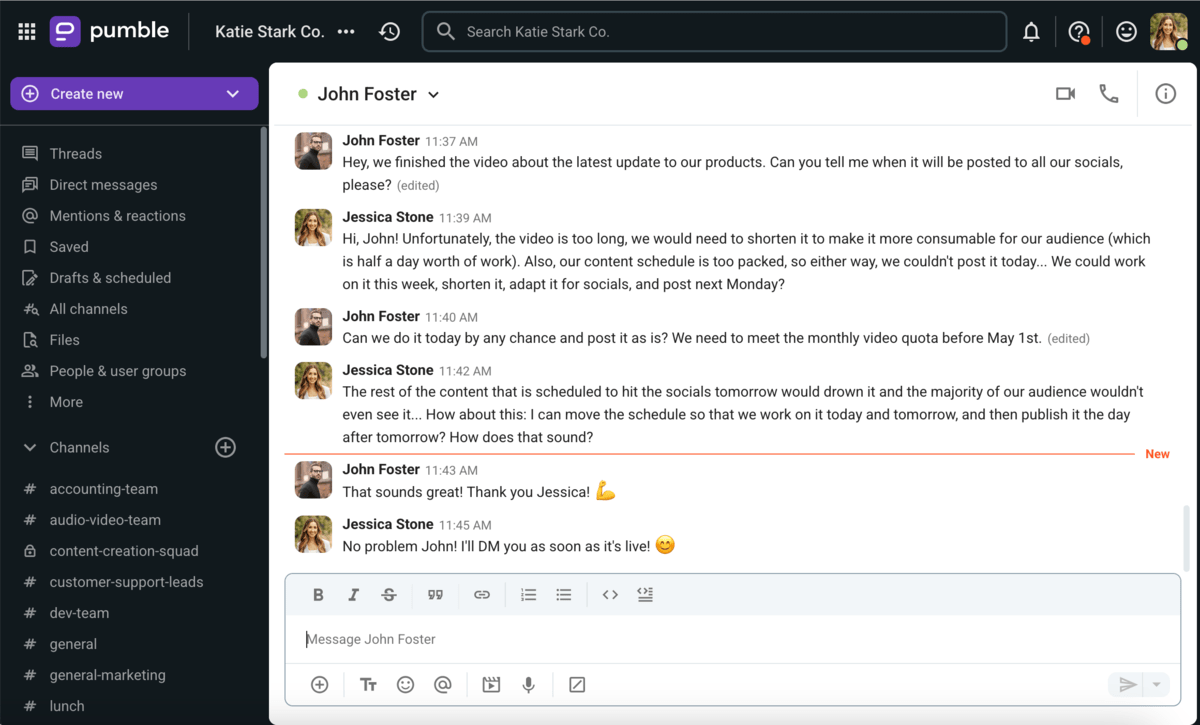
Streamline communication with Pumble
Collaboration skill #4: Organization and delegation
Organizing the workload and delegating tasks are vital for success. If some team members are stretched too thin while others have no tasks, the job at hand won’t be done (or won’t be done well). What’s more, there won’t be any collaboration between the members either.
According to Gretchen Anderson, author of the book Mastering Collaboration: Make Working Together Less Painful and More Productive, giving everyone in the team a role is paramount. She claims that assigning everyone a role makes the team more efficient because it:
- Makes testing new ideas easier,
- Helps people channel their energy,
- Helps determine and maintain boundaries,
- Motivates all participants, and
- Reduces the unnecessary tension associated with task delegation.
Collaboration skill #5: Long-term thinking
Being able to think long-term and envision your goal, as well as all the potential routes the team might take to get to that goal, is long-term thinking or foresight.
Every project has a shared vision or an ideal outcome. Good collaborators are invested in that outcome and are aware of the project’s entire scope. They know what everyone’s role is and how and why that role will contribute to the end goal.
Here’s a good example of how long-term thinking might improve collaboration in a team, shown on Pumble, a business communication app.
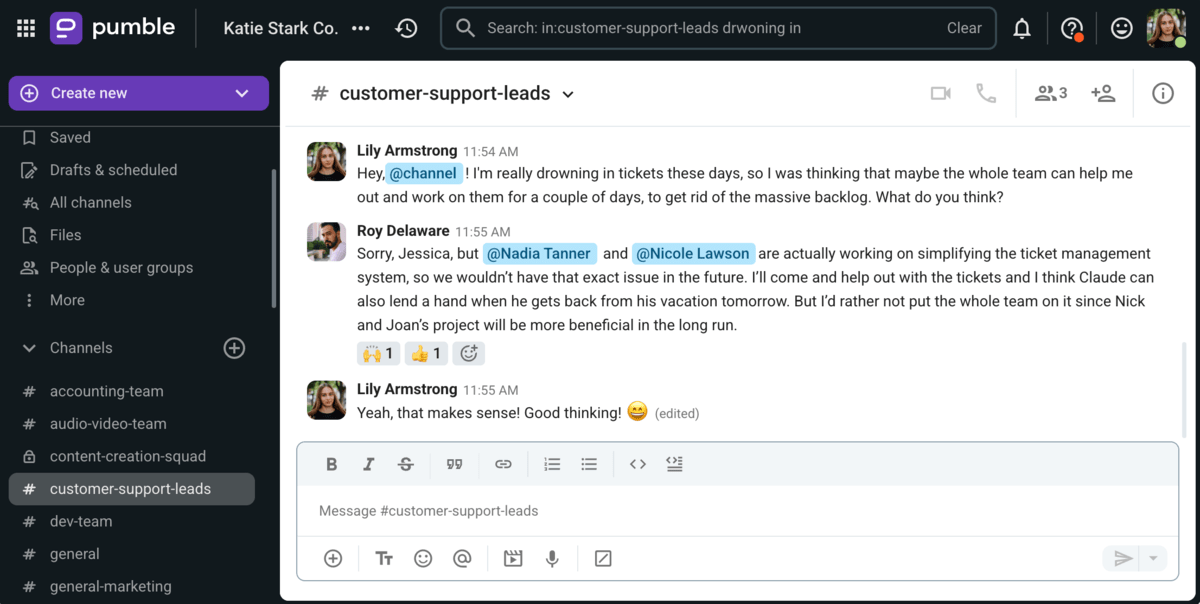
Optimize team processes with Pumble
Collaboration skill #6: Trust
Trust is our belief that our teammates have the necessary skill sets and knowledge to make decisions or execute tasks. Trust aids collaboration, but it’s not a prerequisite for success.
Teams that have members who trust each other are more innovative, because trust allows for quicker decision making and problem solving. However, it takes a long time to build trust in a group, even if it’s a small one.
So, contrary to popular belief, trust isn’t a necessity for success (but it certainly helps).
Trust helps teams overcome obstacles to collaboration, which is why it is one of the key collaborative skills.
Collaboration skill #7: Positivity
When we’re motivated and positive, we can help others by improving their moods.
Promoting positivity in a team stimulates efficiency. Moreover, maintaining a positive attitude can help boost all other collaborative skills. When we’re positive, we:
- Can build trust in a team more easily,
- Are more open-minded,
- Communicate better, and
- Are more willing to compromise.
Collaboration skill #8: Conflict resolution
Conflicts are an inevitable part of teamwork, but, for productive collaboration, it’s important how people handle them.
The ability to effectively resolve conflicts includes several skills, such as:
- Controlling emotions,
- Managing disagreement,
- Negotiating a solution that meets the needs of both parties.
These skills help people acknowledge different perspectives, which helps them find an agreeable solution both sides can benefit from.
How to improve collaboration skills?
If you’re wondering how to develop and improve your collaboration skills, here are some of the most effective ways that will help you become a great collaborator:
- Create psychological safety in your team,
- Communicate your intentions and thoughts clearly and set precise and clear goals,
- Actively listen to other people and recognize their role in the team,
- Compromise and avoid assigning blame,
- Provide constructive criticism to your teammates, welcome feedback, and celebrate the success of your team, and
- Assess the communication skills in your working environment.
Let’s learn more about them.
Tip #1: Create psychological safety
Psychological safety, or the knowledge that we are free to express our opinions and even make mistakes without the fear of repercussions, is not only fragile but also vital to the success of any team.
According to the Harvard Business Review’s research, success of diverse teams significantly depends on psychological safety.
To create a psychologically safe work environment, leaders should:
- Make people feel included,
- Value their viewpoints,
- Ask them for feedback and opinion, and
- Encourage them to learn from their mistakes.
To achieve this, it’s critical that leaders set an example and model behaviors that they want to see in their teams.
Tip #2: Communicate intentions and set clear and precise goals
Because collaboration is so complex, it’s easy for members of a collaborating team to get lost in their own tasks and assignments. That’s why it’s vital that each member communicates transparently.
However, that’s not enough. To foster collaboration, each member has to communicate their intentions in detail.
For example, it’s always a good idea to communicate to your teammates which task you are taking, what you plan to do with it, and when you’re planning on finishing it.
That way, you’re avoiding any potential overlap in tasks with other members and lowering the chances of misunderstanding.
For example, in the screenshot of Pumble’s workspace below, we can see that the members of the audio-video team are organizing their workload by considering deadlines and priorities.
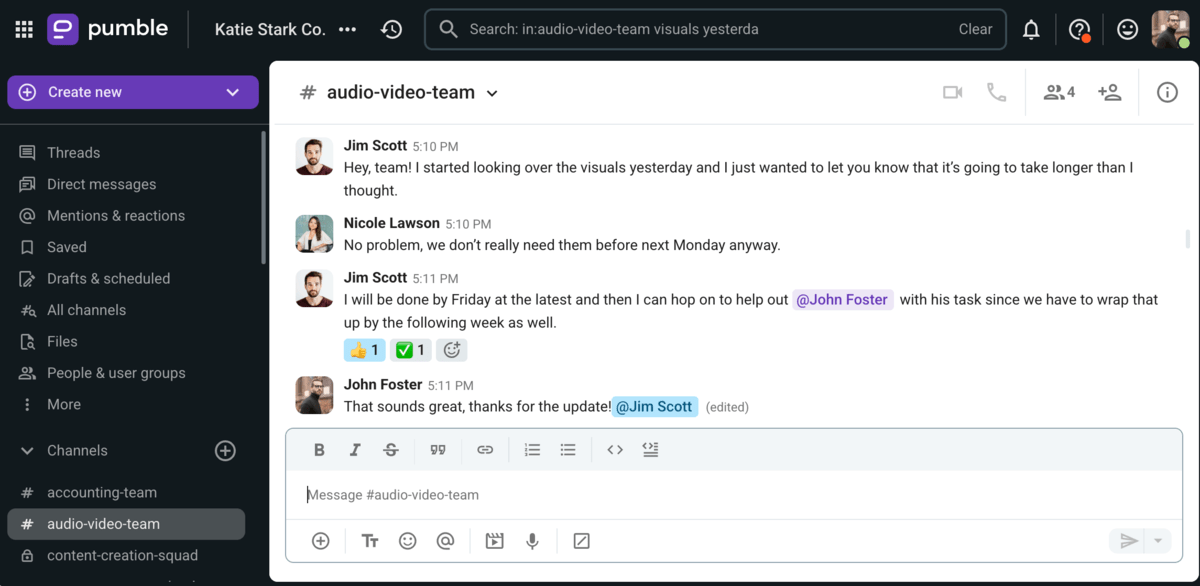
A team that collaborates well also ensures that all their goals are clearly set. They have individual and team objectives that they need to meet, which they are all aware of.
This awareness contributes to deeper collaboration because it makes people commit more fully.
Tip #3: Use active listening and recognize others
By being an active listener, you’ll better understand your teammates, their emotions, and their behaviors.
While understanding is vital, it’s also important that you vocally recognize the roles all other people have in your team. By acknowledging what others do for the team (or for you specifically), you’ll build a better rapport with them and foster a positive environment.
🎓 Pumble Pro Tip
If you want to learn more about how to improve active listening skills, take a look at this article:
Tip #4: Learn to compromise and don’t assign blame
Compromising leads to higher levels of team cohesion and a more positive environment.
Still, even in positive environments, mistakes happen. They are an essential part of progress.
When they do happen, it’s important that your team doesn’t resort to pointing fingers. Challenges arise all the time in teams. Overcoming them without assigning blame is essential.
These situations are the perfect chance for:
- Analyzing the protocols your team has,
- Working together, and
- Finding solutions.
Navigating a situation like that isn’t easy. The goal — improving collaboration without alienating other team members by assigning blame — is best achieved by providing constructive criticism.
Tip #5: Provide constructive criticism and welcome feedback
Giving and receiving constructive feedback or criticism are two sides of the same coin. What’s more, both sides are equally important for the success of your team.
They are essential for good team communication, which is the primary facilitator of collaboration.
The best tips for giving constructive feedback are:
- Start with the positives,
- Establish trust,
- Be specific,
- Schedule feedback consistently,
- Build on the positives,
- Remain honest,
- Deliver feedback face-to-face,
- Provide sufficient context,
- Don’t talk AT the employees (embrace dialogue), and
- Give actionable feedback.
Knowing how to receive constructive criticism is as important as knowing how to give it. Being receptive to constructive criticism and not being afraid to admit that you’re wrong is vital for building trust and it fosters a collaborative environment.
Take a look at the Pumble exchange below to see an example of constructive criticism.
John, the team lead, first addresses the strong points and celebrates the successes of Jim, a new video editor. Then, he steers him in the right direction to meet the team’s and company’s guidelines for brand consistency. Jim accepts feedback happily and is grateful for the constructive feedback.
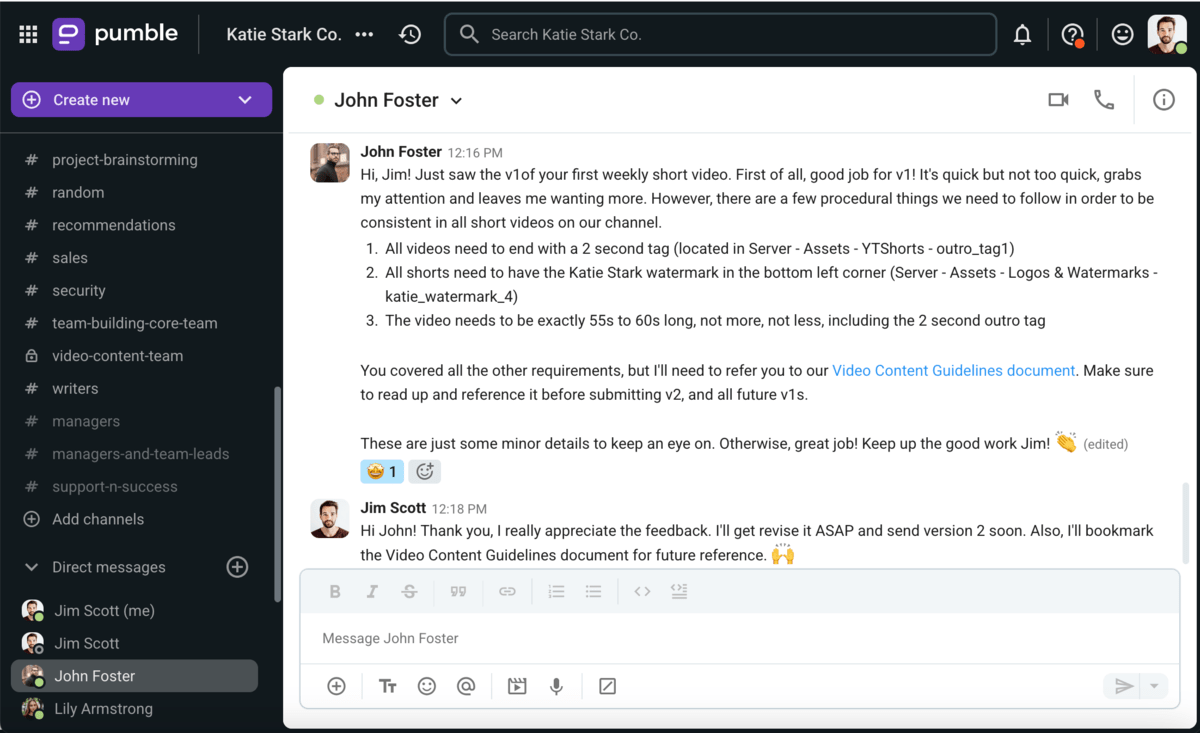
Improve team communication with Pumble
Sometimes, receiving criticism is easier than giving it. When we disagree with our coworkers, it’s vital that we let them know in a respectful and professional manner.
🎓 Pumble Pro Tip
If you’re wondering what the best way to ask for constructive criticism is, check out this article:
Tip #6: Assess the communication skills in your working environment
Finally, make sure to pay attention to communication skills — which are practically inseparable from collaboration skills. Effective communication can safely be considered a prerequisite for strong collaboration in any team.
Communication skills commonly desired in most teams include:
- Asking open-ended questions,
- Asking closed questions,
- Clarifying,
- Paraphrasing,
- Using facilitators,
- Assessing nonverbal communication cues,
- Knowing when to stay silent,
- Written communication, and
- Remote communication.
Make sure to explore relevant communication skills further and approach strengthening your team communication from another perspective, as different approaches will work better for different teams.
🎓 Pumble Pro Tip
To take a closer look at communication skills in the workplace and how to develop them, check out our other Knowledge Hub article:
Why are collaboration skills important?
According to an HRM Online article, effective collaboration skills lead to higher revenue, so they are the top skills employers are seeking in their employees.
Collaboration skills are critical for effective teamwork because they:
- Enhance group cohesion, which improves overall team performance,
- Contribute to better problem solving, and
- Help team members learn from each other.
So, let’s take a closer look at each of these reasons everyone should work on improving collaboration skills.
Reason #1: Collaboration skills improve overall team performance
Collaborative skills enhance group cohesion, which makes team members feel connected with:
- Each other,
- The group goals, and
- Shared values.
That, in turn, helps the team be more effective and productive.
When people are part of a cohesive team, they work on behalf of their team rather than themselves, which increases the success of team collaboration and overall performance.
Reason #2: Effective collaboration skills contribute to better problem solving
When people have strong collaboration skills, they can address and solve problems cooperatively and, thus, more effectively.
People with strong team collaboration skills can better communicate their opinions as well as understand and accept other points of view.
When everyone brings their perspective to the table, chances that your team will find adequate solutions increase.
Reason #3: Good collaboration skills help team members learn from each other
Ultimately, collaboration contributes to both knowledge and skill sharing.
People with strong collaboration skills are more likely to spread their knowledge and learn from other people.
Improve your collaboration skills with Pumble
When it comes to collaboration, there’s always room for improvement. However, choosing the right communication and collaboration tool for the job can quickly take cooperation with your teammates to the next level.
That’s where Pumble comes in.
Pumble is an all-in-one team communication app that helps teams foster collaboration through powerful features, such as:
- Direct messaging — for important 1 on 1 agreements,
- Channels — group spaces for organizing workload and referencing processes relevant to the entire team or subteam,
- Threads — to follow organization and delegation conversations in channels easily,
- File sharing — for implementing effective written communication via documents,
- Screen sharing — to easily share crucial insights with your team,
- Guest Access — for including external collaborators in your communication,
- Mentions — for getting the attention of relevant members in large channels, and
- Video conferencing — for brainstorming, discussing important topics, and team bonding.
Boost your team’s productivity and level up your collaboration.
How we reviewed this post: Our writers & editors monitor the posts and update them when new information becomes available, to keep them fresh and relevant.

